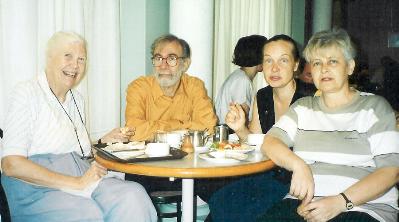Stories
Psychology for Revolutionaries
Psychology for Peace Activists
Why there are so few women warriors
The Seville Statement on Violence
A theory of mental illness
* * *
I had begun my scientific career in the belief that I might discover in the brain some way to make humans less aggressive and less warlike, but by the 1980's I had realized that my original premise was mistaken. I was beginning to understand that anger is the natural response to injustice (and hence indispensable for peace) while those who go to war are not angry, but just following instructions and overcoming fear. This came to a head with the gene for aggression that could be used as a weapon, and I began to realize that the answers I sought could not be found in the brain.
But if there were no brain mechanisms for war, how could we explain that it is men who go to war and not women? This question begged to be answered in a scientific way.
I began reading extensively in the ethnographic literature about warfare among non-European peoples, so-called "primitive war" and I encountered a possible explanation for why there are so few women warriors. It was said by some anthropologists working in New Guinea that women did not go to war because of a contradiction between war and marriage: the warriors of a village make war against the same people (the neighbors) with whom they also inter-marry. In this case, the women could be be trusted to go to war because wars were fought by their husbands on one side and their brothers and fathers on the others side.
Here was a hypothesis that could be tested.
I obtained a semester freedom from teaching in the spring of 1981 at the Wesleyan Center for Humanities, and I took advantage of this to use the Cross-Cultural Human Relations Area Files in New Haven to search for cases of women warriors. If the hypothesis was correct, women would be warriors only when there was no chance of the contradiction between war and marriage, i.e. if you never fought your neighbors or if you married within your own village rather than marrying the neighbors.
Sure enough, when I obtained all the data, the hypothesis was confirmed. All of the nine cultures found to have women warriors were characterized by warfare against distant enemies rather than neighboring tribes (Crow, Navaho, Fox, Deleware and Gros Ventre) or by marriage that took place inside the community rather than with neighboring tribes (Comanche, Majuro, Maori and Orokaiva). On the other hand, there were no cases of women warriors in the 34 cultures that inter-married and made war against neighboring tribes. The odds against such a difference by chance are a hundred-to-one.
I published in the main journal of cross-cultural anthropology, recognized by the experts, but not by the general public, and, as a result, the work is rarely cited by other scientists who continue to search in vain to explain the male-female differences in warfare by some genetic or brain or hormonal mechanism. It's available on the Internet at http://www.culture-of-peace.info/women/title-page.html .
Reconstructing the prehistory of war in the article I published, I said
With the advent of internal war [war against neighboring tribes], patrilocality [wife goes to live with husband] and exogamy [marriage outside the home community], there came a profound shift in male-female relations. The male monopolization of warfare was instituted and extended to hunting (in order to preclude the use of weapons by women) and to the initiation rites of the young (male) warriors. The inequality of power between men and women was institutionalized in a way from which we have never recovered.
In 1992, I came back to this theme in my published essay, Biology Does Not Make Men More Aggressive Than Women, which is also available on the Internet at http://www.culture-of-peace.info/biology/title-page.html .
In 1995, I tried without success to introduce a perspective on the consequences of the prehistoric exclusion of women from war into the statement on Women and the Culture of Peace, edited by Ingeborg Breines at UNESCO for the Beijing Conference.
And in 1998, I did succeed in putting this perspective into the draft Declaration and Programme of Action for a Culture of Peace at the UN (see http://www.culture-of-peace.info/annexes/resA-53-370/page32.html). Equality of women was named as one of the eight principle areas of action for a culture of peace, with the statement:
As recognized by the Fourth World Conference on Women (Beijing 1995), there is an inextricable linkage of peace with equality between women and men. Only this linkage of equality, development and peace can replace the historical inequality between men and women that has always characterized the culture of war and violence.

With Elise Boulding, Riita Wahlstrom and Olga Skaric at a meeting of the International Peace Research Association. Elise wrote The Underside of History: A View of Women through Time. Click on the photo for an enlargement.
The historical perspective that I gained from working on Women Warriors has enabled me to resist the periodic attempts by others to play down the special and unique importance of women's equality as an essential component of the culture of peace. For example, over my objections, it was not given priority in the Manifesto 2000, and I had to fight long and hard with Di Bretherton to ensure that it would be one of the peacekeys in the Culture of Peace News Network rather than simply "equality of all peoples."
 |
Stages
1986-1992
Fall of Soviet Empire
1992-1997
UNESCO Culture of Peace Programme